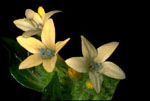 |
Large Flowered Collomia
Collomia grandiflora |
A tall annual that can grow up to 3 feet. Leaves are two to four inches long, lance shaped or elliptical. Pale salmon colored flowers. Appears occasionally in dry, sandy habitats. |
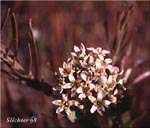 |
Bastard Toad Flax
Comandra umbellata |
Rarely reaches more than 12 inches tall. Spreading rootstocks grow from the rhizomes. Stems grow in clumps. Flowers form a flat topped or rounded cluster. Bastard Toad Flax is a root parasite that extracts nutrients from a wide range of host plants. Thrives in moderately sandy soils of semi arid regions. |
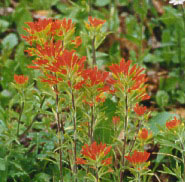 |
Indian Paintbrush
Castilleja chromosa |
Bright showy flower resembles a paintbrush loaded with orange paint. Lower leaves are long, narrow and undivided. Upper leaves are divided into three to five narrow segments. Common in the southern part of the Great Basin. Found in all three sites. |
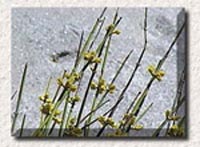 |
Green Ephedra
Ephedra viridis |
Also known as Mormon Tea. The stems are green; the branches are stiff and upright. The structure resembles a sparse broom. Ephedra is common in the ecotone between juniper woodlands and drier communities |
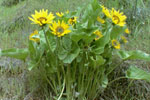 |
Arrowleaf Balsamroot
Balsamorhiza sagittata |
Can grow up to two feet tall. The leaves are large, basal, with broad hairy blades. Cheery yellow flowers. Sunflower family. Leaves are shaped like an arrow. |
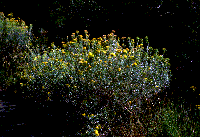 |
Gray Rabbitbrush
Chrysothamnus nauseosus |
Sunflower family. Commonly called rubber rabbitbrush. Grows well on dry soils and is associated with sagebrush. It is a native species, but its presence in dense stands indicates overgrazing. Flowers are yellow, terminal and in large clusters. |
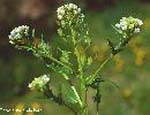 |
Field Pennygrass
Thlaspi arvense L. |
Annual that grows from 6 to 18 inches tall. Also called fanweed. Petals form clusters at the end of the branches. Non-native introduced from Europe. |
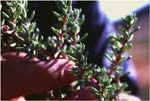 |
Halogeten
Halogeton glomeratus |
Annual that ranges in height from a couple of inches to over eighteen inches. Plants are blue-green in the spring. Leaves are like fleshy spines on red stems. Non-native from Asia. Well adapted to alkaline soils. The plant produces toxic oxalates that are poisonous to livestock. |
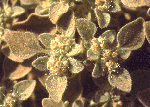 |
Turkey Mullein
Eremocarpus setigerns |
Spreading grayish green annual. The whole plant is covered with tiny star shaped hairs. Native of Pacific coast. Favors sandy soils. |
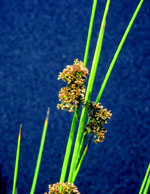 |
Rush
Juncus |
Perennial plant. Erect stems and rhizomatous roots. Round and pointy like a knitting needle. Rushes are generally found on moist sites. This one was found next to Borax Lake. |
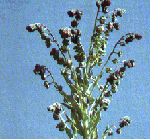 |
Houndstongue
Cynoglossum officinale |
Borage family. This biennial grows from 1 to 4 feet tall. Reproduces by seed. Leaves are alternate, 1 to 12 inches long, 1 to 3 inches wide, rough, hairy, and lacking teeth or lobes. Non-native introduced from Europe. Houndstongue is toxic; containing pyrrolizidine alkaloids that can cause liver cells to stop functioning. |
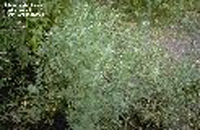 |
Dwarf Sagebrush
Artemisia arbuscula |
Usually no taller than one half a meter. This plant is a darker shade of gray than Big Sagebrush. Grows on poorer soil than big sagebrush. |
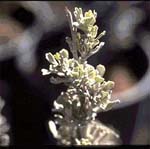 |
Big Sagebrush
Artemisia tridentata |
Over a meter tall. Characteristic silvery green foliage. Cattle find it unpalatable. Similar to Dwarf Sagebrush. |